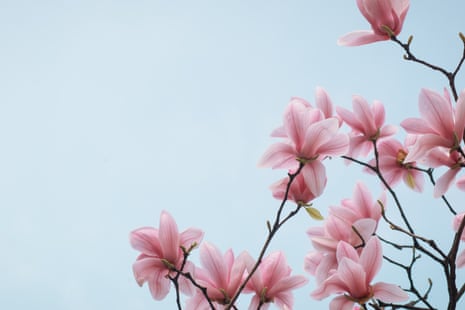Magnolia flowers are some of the first blossoms to open in the Australian springtime. They bloom before there are leaves on the tree, standing out along the artistically gnarled bare branches.
Originally hailing from the northern hemisphere – particularly east Asia – magnolias prefer a temperate-to-cool climate. In Australia you’ll most often find them thriving in front gardens throughout the southern states. They can be grown in pots but prefer deep, rich and slightly acidic soil.
While they’re beloved for heralding the arrival of warmer weather, magnolia flowers are also edible. It’s the petals that you eat, and it’s the younger petals – when flowers are still buds or just opening out – that are the most palatable.

As with most edible wild foods, the older they get, the more bitter their flavour. Different species have different flavours but it is the bog-standard purple and pink tinted saucer magnolia (Magnolia × soulangeana) that is most commonly used in cookery.
The petals have a delightfully powerful clove and ginger flavour, and can be eaten fresh, cooked, pickled and even dried and used in tea. Rob Gould of the Cotswold Forager swears by a fresh magnolia petal wrapped around a chocolate brownie. We’ve also tried them eaten fresh as part of a salad – they pair wonderfully with radicchio, goat cheese, red onion, fennel and orange. They can be infused into a simple syrup for use in cocktails and dessert drizzles, or even dried and ground to a powder to use in place of dried ginger.
It is best to do a bit of extra research about which variety of magnolia you’d like to try using before you munch on it. This site has a great outline of most of the more common species but, remember, as with all foraging, the rule is: if in doubt, leave it out.
How to pickle magnolia flowers
We saw a magnificent tree in a local front yard absolutely bursting with blooms, so we knocked on the door and asked if the owners were OK with us picking a few. They didn’t mind at all, so we collected enough buds and flowers to fill about four jars, then spent an evening getting them into a pickle solution.
Pickled magnolia petals have an incredibly potent spiced, gingery and sometimes clove-y flavour.
They can be used in place of straight-up pickled ginger; dipped in tempura batter and fried, or chopped and tossed through salads in place of a dressing.
They only take two to three days to pickle, and will last in the fridge for six to 12 months, so they’re a great preserve to try while the flowers are in abundance. Once the flowers have been eaten you can keep the beautiful pink vinegar to use in cooking when you want a flavoured acidic hit.
Equipment: One large pickling jar
10-12 young magnolia flowers or large flower buds
250ml rice wine vinegar
1/4 cup white sugar
A pinch of salt
Gently wash and dry the flowers then remove any brown, papery bracts from around buds, and any bruised petals.

If using buds, cut the stems right to the base of the flower. If using opened flowers, remove the petals from the centre.
Sterilise a large jar then place the washed buds or petals inside it. Using tongs or a flat knife can help squeeze buds in. Rolling individual petals into rosettes will help keep them submerged.
Heat the vinegar, sugar and salt to boiling, then simmer for five minutes.
Pour the hot vinegar solution over magnolias until they are completely covered. Quickly seal the lid while hot and invert the jar for one minute. This helps heat air inside the jar and means you’re likely to get a better seal as it cools.
Allow the jar to cool to room temperature then put it in the fridge. Allow to mellow for two to three days before opening, and store in the fridge.
Anna Matilda, AKA the Urban Nanna, uses permaculture principles to teach traditional skills, crafts and methods of living in the framework of a modern-day world

Comments (…)
Sign in or create your Guardian account to join the discussion